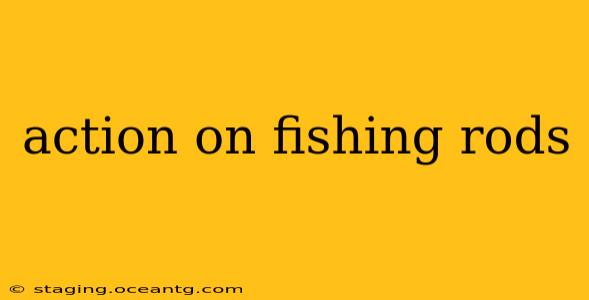Choosing the right fishing rod hinges significantly on understanding rod action. This crucial aspect determines how the rod bends under load, directly impacting your casting distance, sensitivity, and overall fishing experience. This guide delves into the nuances of rod action, helping you select the perfect rod for your angling needs.
What is Rod Action?
Rod action refers to how much and where a fishing rod bends when pressure is applied, typically from a fish pulling on the line or during the casting process. It's generally categorized into different types, each exhibiting unique characteristics:
-
Fast Action: These rods bend primarily in the tip section, offering precise control and excellent sensitivity for detecting subtle bites. They're ideal for techniques requiring accurate casts and quick hooksets, like finesse fishing or targeting wary fish. The energy transfer from the rod to the lure is rapid and efficient.
-
Medium Action: Medium-action rods bend along a larger portion of the blank (the rod's shaft), offering a good balance between power and sensitivity. This makes them versatile for various fishing techniques and target species. They provide a smooth casting action and sufficient power for fighting larger fish.
-
Slow Action: Slow-action rods flex significantly along their entire length, from tip to butt. This parabolic bend absorbs shock, making them ideal for battling powerful fish without risking breakage. They are less precise for casting but excel at preventing hook pulls during the fight.
What are the Different Types of Rod Action?
While fast, medium, and slow are the broad classifications, manufacturers often use more specific terms to further define action:
- Extra Fast: Even stiffer than fast action, these rods are extremely sensitive and ideal for precise presentations.
- Moderate Fast: A happy medium between fast and medium, offering a balance between power and sensitivity.
- Moderate: Similar to a medium action but often leaning slightly towards the slower side.
- Extra Slow: These rods bend very dramatically along their entire length, best suited for very large fish and strong line.
How Does Rod Action Affect Casting Distance?
Rod action significantly influences casting distance. Fast-action rods generally allow for longer casts due to their efficient energy transfer, but mastering the technique is crucial. Slower action rods require a more deliberate casting technique, which can result in shorter casts. However, the flexibility helps absorb shock and keeps hooks secure during longer fights.
What is the Best Rod Action for Beginners?
For beginners, a medium-action rod is generally recommended. They offer a forgiving nature, balancing power and sensitivity, which is easier to learn with than other options. They're versatile enough to handle a variety of situations and fish species.
How Do I Choose the Right Rod Action for My Fishing Style?
The best rod action depends on your fishing style and target species.
- Bass Fishing: Medium-fast to fast-action rods are popular for bass fishing, offering a balance of power and sensitivity for various techniques.
- Trout Fishing: Light to medium-fast action rods are often preferred for trout fishing, prioritizing sensitivity for detecting subtle bites.
- Surf Casting: Slow to medium-slow action rods are commonly used for surf casting, providing the power needed to cast large lures and fight strong fish in heavy currents.
How can I tell the action of a fishing rod?
Rod action is often indicated on the rod itself, usually labelled with a descriptive term such as “fast” or “medium.” You can also check the manufacturer’s specifications. Feeling the rod flex and comparing it to a friend's rod can also provide clues. However, keep in mind that different manufacturers may have slightly different interpretations of the action terminology.
This comprehensive guide helps clarify the significance of rod action in fishing. Remember, selecting the correct rod action improves your overall fishing experience by matching the rod’s characteristics to your fishing style and target species. Happy fishing!
